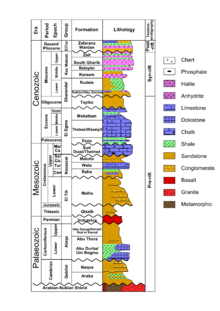User:Dciaccio/sandbox

The Belayim oil field in located in the Gulf of Suez, 165 km SE of Suez City, Egypt. The area is comprised of the Belayim Land and Belayim Marine oil fields, discovered in 1955 and 1961 respectively. The Belayim Marine oil field was the first offshore oil field discovered in Egypt, located 9 km away from Belayim Land.[1] In 1978, explorations began by the Compagnie Oriental des Petroles D’Egypt (COPE), which was then owned by the International Egyptian Oil Company. Over 50 years of exploration have depleted oil reserves within the Belayim oilfield by over 75%. However, the oil fields still hold over 600 million barrels of oil, expected to produce over 75,000 barrels per day through 2020.[2] In 2009, a new license was negotiated between Eni and the Egyptian Minister of Petroleum. The license extends production through 2030, with a commitment to spend over 1.5 billion on optimizing development.
Geologic Setting
[edit]
Oil reserves within the Belayim oil field are contained within the Gulf of Suez rift basin, which formed as a result of crustal stretching and depression within a set of normal faults. The rift formed between the Late Oligocene and the end of the Miocene. The consequential rifting allowed for the deepest part of rifted topography to hold water, eventually forming the Gulf of Suez.[3] The Belayim Land and Belayim Marine oil fields experience slight differences in terms of structural configuration. The Belayim Land oil field contains a N-S trending anticline and a set of normal faults, along with a set of strike-slip faults. The Belayim Marine oil field contains a faulted monocline in the Pre-Miocene, along with a faulted double-plunging anticline in the Miocene.[1]
Lithology
[edit]
Lithology within the Belayim Oilfield is indicative of the processes caused by the Gulf of Suez rift. Variations within lithology, thickness, unconformities, source rocks and oil production are evident due to the rift. Stratigraphy within the Belayim oil field can be categorized into 3 major sequences; a pre-rift, synrift, and post-rift. The pre-rift mega sequence covers the pre-Miocene, and includes Precambrian crystalline basement rocks. Synrift extends from the Oligocene to Miocene, while the post-rift sequence details the Post-Miocene interval.[1] The sandstone deposits within the lithology are very porous and permeable. Porosity equals 21-25%, K<1000mD.[4]
Oil Production
[edit]Source Rocks
[edit]The majority of source rocks within the Gulf of Suez province lie within the Pre-Miocene succession. Lithology within this area include fine clastics and carbonates within the Nubia-B formation, brown limestone in the DAWI formation, as well as the ESNA shale formation. Secondary source rocks can be found within the Mid-Miocene succession, represented by fine clastics and shale in the Kareem, Rudeis, and Belayim formations.[4] The main type of petroleum generation within the Gulf of Suez includes oil-prone type II kerogen. Type II kerogen is mostly indicative of shale deposits, formed in marine environments from the decomposition of planktonic material. These marine shales tend to form a mixture of oil and gas, with substantial amounts of sulfur deposits.
Traps and Seals
[edit]The traps and seals within the Belayim oil field vary within the geologic time scale of the Gulf of Suez rift. The Miocene evaporates serve as the ultimate seal for the hydrocarbon reserves found in the area. The shale and limestone deposits of the pre-rift and synrift lithology also serve as major hydrocarbon seals. Structural evolution from the Gulf of Suez rift serve as the major form of traps within the area. A set of normal faults with a double plunging anticline in the Miocene, along with a faulted monocline in the Pre-Miocene present the perfect trapping mechanism for an area with major evaporite seals[4].
Maturation
[edit]Thermal maturation includes the action of heat flows affecting buried organic matter, cooking hydrocarbons into future oil and gas generations. Compared to other hydrocarbon systems that generate type II kerogen, the Belayim oil field is relatively immature. Source rocks from the Thebes formation are the most varied in terms of maturity, ranging from semi-immature to mature. The brown limestone extracts are the most mature source rocks within the Belayim oil field succession. Due to a lack of thermal maturation within the lithology, source rocks fall in the early oil window, decreasing the amount of clean oil production.
- ^ a b c El Daisty, W. Sh. (April 2015). "CRUDE OIL GEOCHEMISTRY AND SOURCE ROCK POTENTIAL OF THE UPPER CRETACEOUS – EOCENE SUCCESSION IN THE BELAYIM OILFIELDS, CENTRAL GULF OF SUEZ, EGYPT". Retrieved November 30.
{{cite web}}: Check date values in:|access-date=(help) - ^ "Egypt Oil and Gas". Egypt production report. 8 p..
- ^ Abd-Allah, Ali M.A (Aug. 2014). "Structural evolution of the southern transfer zone of the Gulf of Suez rift, Egypt". Science Direct. Journal of African Earth Sciences.
{{cite web}}:|access-date=requires|url=(help); Check date values in:|access-date=and|date=(help); Missing or empty|url=(help) - ^ a b c Abu Al-Atta, Mohamed; Ibrahim Issa, Ghalib; Ahmed, Mohammed A.; Mustafa Afife, Mohamed (2014-09-01). "Source rock evaluation and organic geochemistry of Belayim Marine Oil Field, Gulf of Suez, Egypt". Egyptian Journal of Petroleum. 23 (3): 285–302. doi:10.1016/j.ejpe.2014.08.005.
